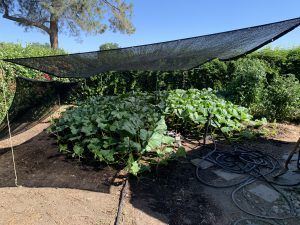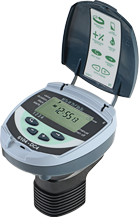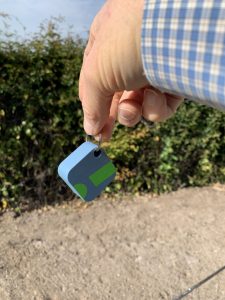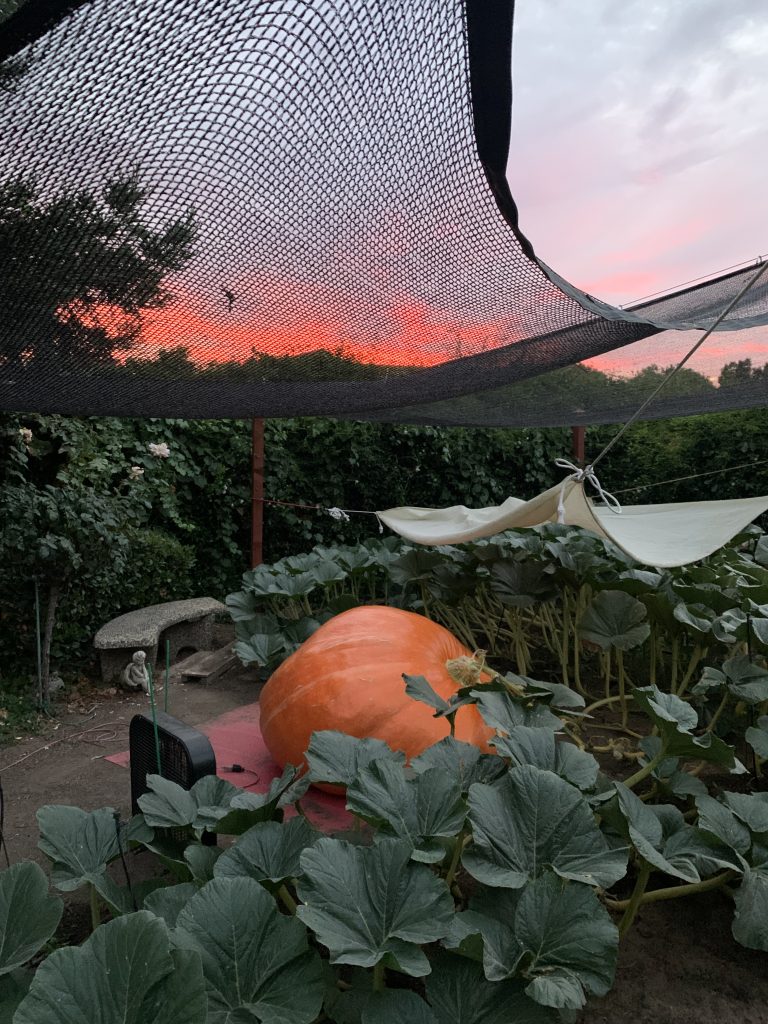I share some select product recommendations and this page contains affiliate links. If you take action (click on the link and purchase the product), I will earn some loose change. I hope you take advantage of my recommendations. You do not pay a higher price. – Jeffrey McLain
Many of you may be growing big pumpkins in the heat. My pumpkin patch is in Lodi, California. Lodi is part of the Central Valley, where fruits and vegetables flourish due to the excellent climate and soils. However, the intense heat that is suitable for some fruits and vegetables can be tough on pumpkins. Pumpkins do best when the air temperature is between 65 and 95 degrees Fahrenheit (ca. 35 °C). Furthermore, pumpkin plants dislike large temperature fluctuations between days and nights. What does a grower do about temperatures exceeding 95 degrees Fahrenheit (ca. 35 °C)? What about 115 degrees Fahrenheit (ca. 46 °C)?
When it gets too hot, your pumpkin plant will wilt. The leaves will droop and appear as if the plant needs water. Even if there is plenty of water, intense heat can cause wilting. It is believed that the pumpkin stops growing during wilting. Some pumpkin plants are “wilters” and some appear to withstand heat better than others. Growing two different pumpkin varieties in the same location makes this very clear. No two plants are alike.
In severe cases of heat, the leaves will brown and become crispy. This is a very undesirable situation. The leading tip of the primary is especially susceptible to heat damage. One year, my primary vine got crispy and just broke off. Yes, growing big pumpkins in the heat is challenging indeed.
I use several tools to battle the elements. First, I use shade cloth for cooling purposes. In addition to shade cloth, my other weapon is misting. Misting is extremely efficient at cooling the plants. Some monitoring tools are also useful to track your progress during hot days.
Shade Cloth for Growing Big Pumpkins

Shade cloth can be used to keep intense heat off of pumpkin plants. Shade cloth is categorized by the fabric density. Vegetables typically need shade cloth between 30% and 60%. This means that between 30% and 60% of the sun’s light shines through the fabric.
There are ongoing discussions about the best type of shade cloth on bigpumpkins.com. The prevailing thought seems to be 30% or 40%. You can find shade cloth just about anywhere, however it can be difficult to determine the density. For example, Home Depot and Lowes both have shade cloth, however, it appears higher density.
The cost of a custom shade cloth can be high. My patch, which is barely 700 square feet required an odd-shaped cloth costing nearly $300. I wish I had a rectangular shaped area but it is not the case.
Mounting Shade Cloth
You can rig shade cloth with temporary posts, trees, and other structures. You can also install permanent posts or use shade cloth over greenhouse structures. I would recommend that you determine how you intend to utilize the shade cloth. If you intend to use it temporarily during heat waves, I recommend a system to allow easy removal and installation. Otherwise, you risk damage to your pumpkin plant when installing and removing.
A permanent solution is easier on your pumpkin plant as you won’t walk through the patch and risk plant damage. I strung shade cloth temporarily between trees, temporary posts and my shed for the last few years. There were several problems with this set-up. First, it was difficult to remove the shade cloth and install it without damaging the delicate pumpkin leaves. During heat waves I definitely left the shade cloth up 24/7, but when the heat waves broke I would remove the cloth. I also used a cloth purchased online of unknown density. Likely a much higher density.
The 2023 Shade Cloth Setup
Gardeners use shade cloth for various reasons to provide shade and control the amount of sunlight that reaches their plants. This is done for sunlight regulation as the shade cloth helps in regulating the amount of sunlight that reaches plants. Some plants, especially those that are sensitive to intense sunlight, may require partial shade to thrive. Another reason is for temperature control. Shade cloth can help to reduce the temperature around plants by blocking a portion of the sunlight. This is particularly useful in hot climates where excessive heat can stress or damage plants. Shade cloth can help protect your pumpkin plants from sunburn and overheating as well.
This year, I installed permanent posts in my patch. I put five posts around the perimeter with eye bolts. My patch is an odd shape and I purchased a cut to order 30% shade cloth from the Shade Cloth Store. They helped me design my odd shaped cloth and were very easy to work with. This year, the shade cloth will be installed all season. It will be used with my misting system to keep the patch cool.
Using Mist to Cool your Pumpkin Plants

Misting is highly recommended for keeping your pumpkin and plant cool. There are several misting system types. The most critical thing to figure out first is what type of automatic system you need. Like most pumpkin growers, I have an assortment of timers or irrigation controllers in my patches. However, I needed a more sophisticated device that could handle nearly unlimited irrigation durations.
I opted for the Galcon 6100 Battery Operated Irrigation Controller. This controller will run the misters once every five minutes for a specified amount of time. For example, when the temperature in the patch gets over 90 degrees at 10:00 AM and doesn’t drop below that until 8:00 PM, I can run the misters between those times. This will keep the plants cool. This timer is easy to set up and comes with excellent customer service.
The next decision to make is the type of mist system: suspended or on the ground. You will need to decide which system is best for you and your situation.
The 2023 Misting Setup
For 2023, I used misters set on 36-inch tall stakes attached to the main housing. There are a total of 30 misters placed across the patch. This will definitely ensure adequate coverage.
Monitoring Temperatures with Loggers

To help me figure out the temperatures in my pumpkin patches, I started using a temperature sensor. The SensorPush HT1 is a little square device that measures temperature and humidity every minute. It connects with your smartphone with blue tooth technology. These little guys are easy to move around and can help determine when the temperatures become hot. In addition, these loggers can be installed inside hoop houses and underneath covers at night to monitor cold temperatures.
Learning more about Growing in the Heat
Growing big pumpkins in the heat is challenging, it is possible to successfully grow a giant. For more information about growing big pumpkins, see my Garden Blog. For detailed information about growing giant pumpkins, see my book, Backyard Big: Growing Atlantic Giant Pumpkins in Your Backyard on Amazon and Barnes & Noble.

